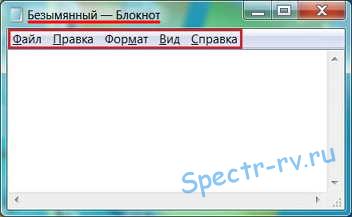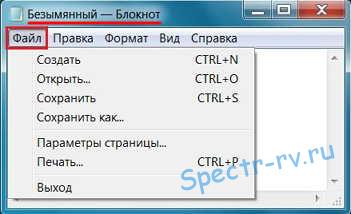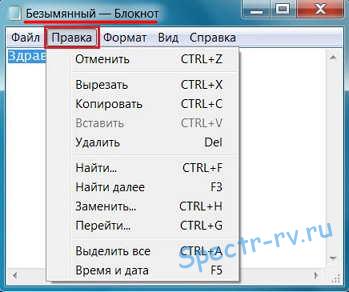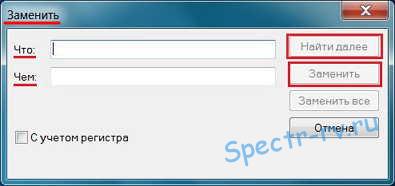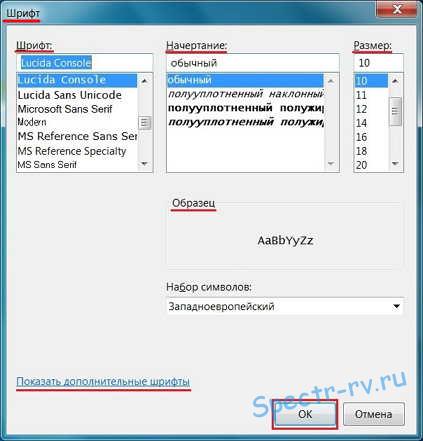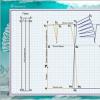Instruction
If you did not find in the usual place (section "Programs", subsection "Standard") links to launch notepad, then you can create it again here. This can be done in several ways. For example, you can open Explorer (shortcut CTRL + E), go to the system32 folder, which is stored in the windows folder and find the executable file there Notebook a - notepad.exe. You then need to right-click it and drag it to its original launch link location. That is, first drag it to the "Start" button, hold it without releasing the button until the menu opens, then drag it to the "Programs" section, also wait for it to open, move it further to the "Standard" subsection and release the button there. Explorer will ask what needs to be done - create a copy, move the file here, or create a shortcut. Select "Create Shortcut" and then right-click on the newly created item named notepad and rename it to " Notebook».
If the point is not the absence of a link, but the fact that Notebook does not open when you select the corresponding item in the menu, then the matter is a little more complicated. The executable appears to be corrupted and needs to be replaced. You can search for this file on the installation disk of the operating system or on the Internet and replace the corrupted one with a new version. It is stored in the Windows system folder, in the system32 folder.
There is an alternative option - instead of the spoiled one Notebook and install a similar application from another manufacturer. Such text editors that retain the benefits Notebook but providing additional features, you can find a lot on the net. For example, if you install a program called NoteTab on your computer, then it will do all the necessary operations to replace itself. Notebook and if you select Replace MS Notepad in the Help section.
Related videos
The simplest text editor "Notepad" (aka notepad) is a convenient tool for reading and editing simple test files. Sometimes users have difficulty launching it, although in reality there is nothing difficult about it.
Related videos
The simplest text editor in Windows Notebook does not support text formatting and is often useful for this. For example, copying text typed in Notebook That is, you can be sure that it does not contain formatting tags hidden from you that are present in the texts of more advanced text editors (for example, Word). If this useful program is lost on your computer, then there is an easy way to find it.
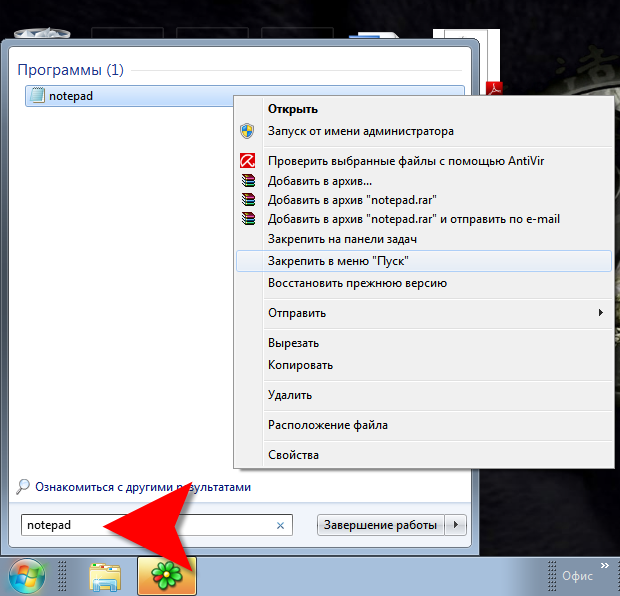
Instruction
Expand the main menu on the "Start" button, go to the "All Programs" section, and then to the "Accessories" subsection. The operating system places the run command in this subkey. Notebook and in the process Windows installation. If it is not here, then use one of the methods described in the second or third step to search.
If you need to find Notebook in Windows 7, then use the sequence of actions described in the third step. In Windows XP, open the main menu on the "Start" button, and in it the "Find" section and select "Files and folders". In the search query input window, type notepad.exe. You can copy here (CTRL + C) and paste into the input field (CTRL + V). Click the "Search" button and wait for a while - depending on the number of files stored on your computer's media, the search procedure may take from several seconds to several minutes. When the process is completed, you will receive a list of files named notepad.exe. Please note: if your computer has (or was previously installed) several operating systems, then there will be several such files and it is better for you to choose the one that is located in the system folder of your current OS for subsequent use. The storage location of each of the found files can be seen in the "Folder" column. In order not to search Notebook each time, create a shortcut to launch it by dragging the found file with the right mouse button in the menu on the Start button or on the desktop.
In Windows 7, open the main menu on the Start button and type notepad in the search query input window. You can copy here (CTRL + C) and paste into the input field (CTRL + V). Windows will find Notebook. Hover over the line with the found program and right-click it. In the context menu, you can select the "File Location" item to open the folder in Explorer where the program's executable file is located. You can click the “Properties” item to see in the “Location” line of the file properties window the address of its location on the computer. Or you can click "Pin to Start Menu" or "Pin to Taskbar" to avoid using search next time.
Related videos
Sources:
- where is notepad in computer
Notebook is a lightweight program for opening and editing text documents. Usually it is already preinstalled in operating systems as a standard tool necessary for work, however, there are also additional versions that have an extended set of functions.
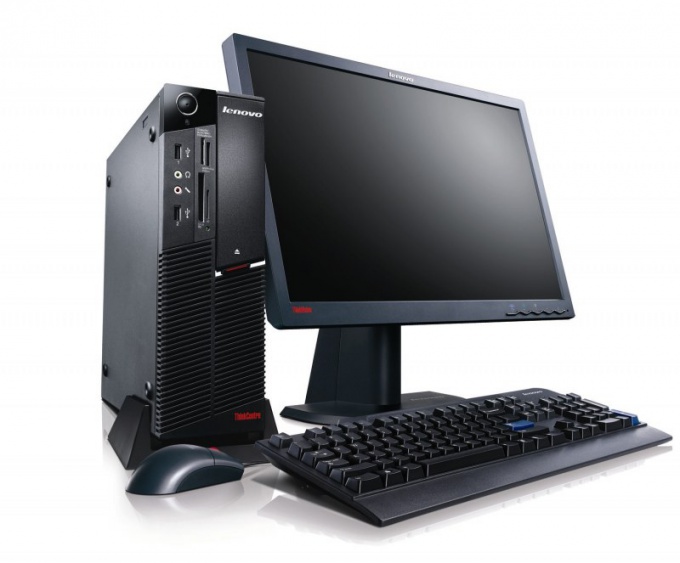
You will need
- - Internet connection.
Instruction
Make sure you have a working internet connection. Open a browser and enter in the search bar the name of any convenient program for further use in the work of a program like the standard " Notebook a" or just look through the list of programs with a description of their functions. Compare prices, decide on the selection criteria, find out for yourself what features are important to you, and so on.
Download the program of your choice for editing text documents. If it's free, you can start using it right after installation, and if not, you'll likely be prompted to activate a trial period, after which you'll have to decide whether to buy a license key.
If you decide to buy license key to your new text editor, open the program activation menu or go to the developer's official website in the license purchase section. You will need a bank card to pay.
Before making a final decision on payment, look at other free analogues of the program and compare their functionality. When paying, be extremely careful when entering data - they must be accurate and without errors.
Also make sure that the correct address is in the address bar - this is necessary in order to avoid unpleasant incidents associated with fraud. It is better not to save the fields you filled in in the browser for further automatic filling, since they can be used by strangers who have gained access to your computer.
In order to use the notepad you downloaded and installed to open files by default, right-click on a text document and select "Open with ..", then select the desired program in the list of programs or add it there using the "Browse" button menu ”, specifying a directory in Program Files. Check the box "Use for all files of this type" and click "OK".
5.
6.
7.
8.
9.
10.
About Notepad
About Notepad
Notepad creates text files.
A text file is a type of file that can be
identify by filename extension .txt.
The default filename is "Unnamed".
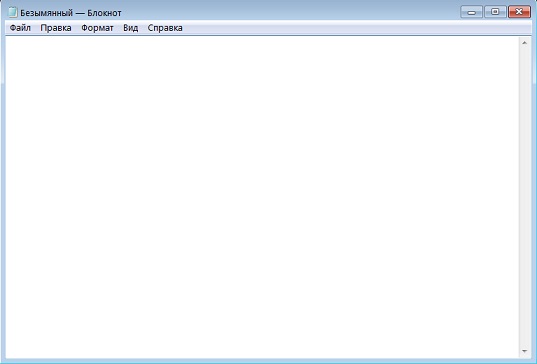
You can also create and edit web pages with Notepad while learning the basics of HTML. Although, judging by my own experience, such complex work as comprehending the basics of the HTML language is better in WordPad, and it is easier to do work in Notepad.
By default, Notepad creates, opens and saves documents with the TXT extension, but you can also open files with the INI, INF, LOG extensions.
To run files of any other type, run the command:
"File" → "Open" → in the file type field, select "All files",
then select desired file.
Notepad allows you to work with texts in ANSI and Unicode encodings,
and also convert from one format to another. To do this, when saving the document, select the desired encoding in the appropriate field.
Suppose you found something interesting on the Internet (news, story,
poems, etc.) - read it yourself and want to send to friends - "highlighted"
the text you liked, “copied” it with the right mouse, “pasted”
first into Notepad, and then already “inserted” - either into an email
friend, or in a message on a social network ("Odnoklassniki", "My World"
etc.), or “saved” in a folder on your computer. Very comfortably!
How to work with Notepad
How to work with Notepad?
Working with Notepad
I will describe in an accessible way, for
novice user, form.
How to find the Notepad program on a computer -
shown in the screenshot on the page Text editors
On the top panel of the program -
File, Edit, Format.
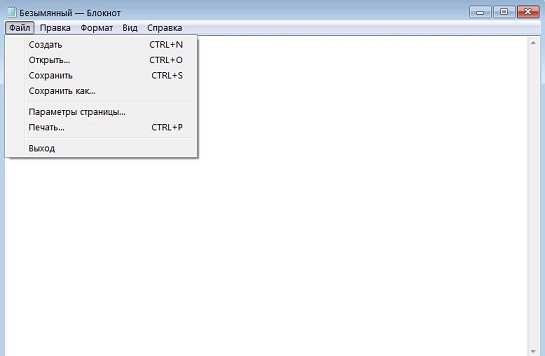 how to create, open, save, print documents in Notepad
how to create, open, save, print documents in Notepad How to create, open,
save, print
documents in notepad
File - "Creates", "Opens", "Saves", "Prints"
documents in notepad.
To create a new document - click "File" → select "New"
and start typing. Or you can not click on "Create". Since you already have Notepad open, you can immediately print and then save your document.
If the document is new, then select "Save as ..." to save.
In the "Explorer" window that opens, select the folder where you will save,
In the line "File name" write the name of the document and click "Save".
To open a previously saved document,
then click "File" - select "Open".
"Explorer" will open with the "Documents" folder, find your previously saved
document and either double-click to open that document yourself, or click
once on that document to highlight it and then at the bottom of the Explorer window, click Open.
Or you can do it without the “File” - find your document yourself in the “Documents” folder and double-click to open it. In all cases, the expected result will be. You will open a previously saved document and you can make changes to it.
If you, in a previously saved document, make any changes,
then click "File" and select "Save".
To print your document
click Notepad's File menu → select Print.
In the "General" tab that opens, select the printer and its settings,
and then click the "Print" button. If you want to change the type of printed
document, click the File menu, and select Page Options.
My Observations on the Vagaries of the Notepad Program
If you will be doing some large print work, then you should consider
that the Notepad program is rather capricious, therefore, in order not to do unnecessary
work - save the document at the beginning of work, i.e. printed the name of the document -
click "File" → "Save as ..." and in the already saved document, typed a short text → click "Save", typed a little more and again → "Save".
And always keep an eye on the cursor - whether it is in the place where you need to type.
How to copy, cut, delete in Notepad
How to "Cut", "Delete",
"Copy", "Paste" in Notepad
"Edit":
"Cut", "Delete", "Copy", "Paste" - already "selected" text.
"Undoes" the last action done in Notepad.
Searches and replaces characters and words in the text.
Inserts the time and date into Text Document.
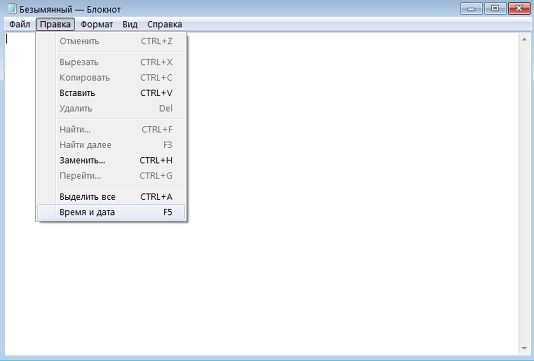
Before removing, cut,
copy, paste - the text must be selected.
How to highlight text in Notepad
How to highlight text in Notepad
"Highlight text" (words)
can be done in two ways:
1.
Put the cursor at the beginning (end) of the text (word) and pressed,
left mouse button, drag the text (word) to the right,
if you put the cursor at the beginning.
And to the left, if you put the cursor at the end of the text (word).
Selected text turns blue.
2.
Place the cursor at the beginning (end) of the text (word), press
and hold the Shift key with one hand while pressing the other
text navigation key, right (→) or left (←).
With text (word) already selected - you can "Cut", "Delete",
"Copy", "Paste". To do this, click "Edit" and do what
what you intended: cut, delete, copy, etc.
In order to remove the "selection" - just click the left mouse
on the white field of "Notepad" or in "Edit" and select "Cancel".
To execute the "Paste" command, you must first copy
(or cut if you don't need the text at that point) selected text
in one place and then put the cursor in the place where you want to paste
text, and then either Edit and choose Paste, or click
right mouse button and select Paste.
If you need to select all the text printed in the document, then press
"Edit", select "Select All" and then click "Edit" again,
choose what you were going to do with this text - cut, copy
or delete.
How to undo the last action in Notepad
How to undo the last action in Notepad
If you cut something, deleted it, etc. and immediately, without taking
any actions in Notepad, change your mind, then click "Edit"
and select Cancel.
The "Undo" command can also be executed with the right mouse button -
just right-click and select from context
Undo menu.
I must say that the "Undo" command in Notepad (unlike WordPad) -
undoes only the really last action. If you, after canceling,
press the "Cancel" button again - the program will return the previously canceled
action. Whereas WordPad - undoes the last action in sequential order.
To make it clearer, let's take a numerical sequence - 1,2,3,4,5.
WordPad will undo first 5, then 4, then 3, and so on. A Notepad, with each
command "Cancel" - first cancels 5, and then returns 5 and again cancels 5.
~~~~~~~
Let me remind you again that the same actions in Notepad
with "highlighted" text: "cut", "delete", "copy",
"cancel", etc. - can be done without going to "Edit".
Press the right mouse button and select from the context menu
what they wanted to do with the text (word).
~~~~~~~
Find and replace characters and words in a Notepad text document
Find and replace characters and words
in a notepad text document
Suppose - you need to find some character or word in the document. For this -
click the Edit menu and select Find. As a result, it will open
such a tab.
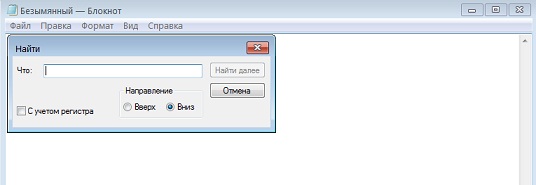
In the "What:" field, enter the text you want to find. In the "Direction" group
click "Up" to search from the current cursor position to the beginning of the document
or click Down to search from the current cursor position to the end of the document.
And click the "Find Next" button. The word or character will be found and highlighted.
If you want to replace one word with another in the text -
then from the Edit menu, select Replace.
A tab will open with two lines.
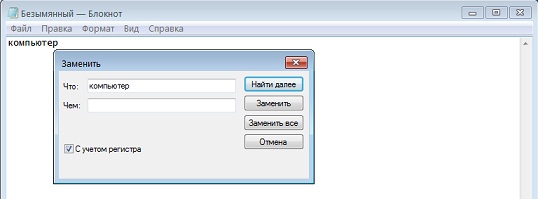
In the line "What:" - enter the word (or character) that you want to replace.
In the line "What:" - enter the word you want to replace. And then
click "Replace". Or "Replace All" if the word you want
replace - repeated several times in the text.
And as a result, the word will be replaced.
How to format a font in Notepad
How to format a font in Notepad
"Format"
"Format" is responsible for formatting
(change) font, style and font size.
If you want to change the font,
font style or font size, then click Format.

Select "Font".
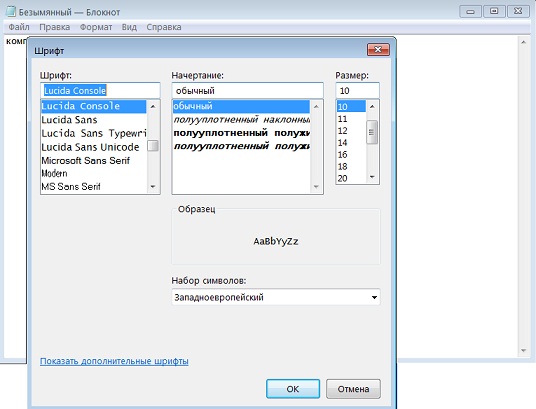
In the new tab, in the "Font" section, you can select a font.
In the "Style" section, you can choose the style (bold, italic).
In the "Size" section, you can choose the font size (12, 14, 16, etc.).
You can, if you want, change the "Character Set"
from Western European to Cyrillic or others.
If you print your document but none of the fonts
in this tab you did not like - you can choose others.
To do this, click on the link "Show additional fonts".
File Explorer will open with many more fonts.
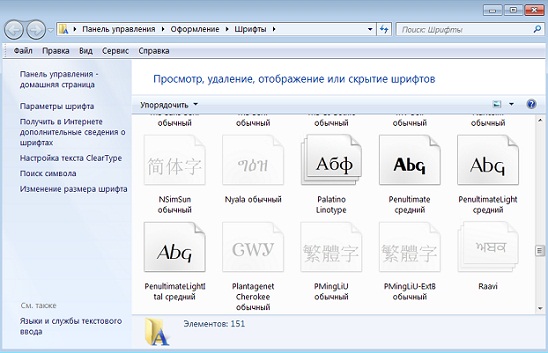
Double click on the one you like
font in File Explorer and a new tab will open.
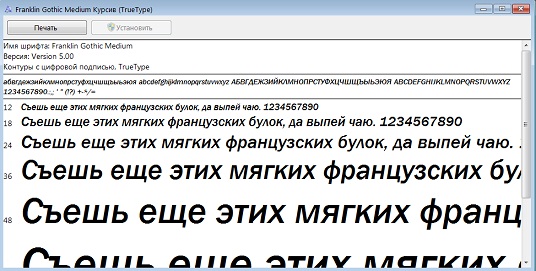
In this tab you can choose the font size
and then click "Print" in the upper left corner.
And more about the font. If you (not for printing, but for normal work in Notepad) have changed the font for only one document, then when you finish working with this document, return the font to its original position. Otherwise, Notepad will exit with a changed font next time.
As you can see, the Notepad program is very simple.
and easy to work with!
Instruction
To create a text file through Notepad, you must first open the program itself. To do this, call the Start menu. In it, move the mouse cursor over the line "All Programs" and select the line "Accessories" in the menu that appears. In the list of standard programs, click on the line "Notepad" once with the left mouse button.
After starting the program, a Notepad window will appear in front of you with an empty text file, which you can immediately change as you need (type the text you need or copy it from other text files).
If you need to create an empty file with the extension ".txt", then in the Notepad window, click the "File" button located in the upper left corner of the screen. Select "Save" from the menu that appears. A file save window will open in front of you, in which you need to specify the location directory, file name and its format. After specifying all the data you need about the file, click the "Save" button.
You can create a Notepad file in another way. To implement it, open the directory you need, in which the future text file should be located. Then right-click on any empty space in the selected folder once. In the action selection menu that appears, hover over the "Create" line. In the drop down list of types files select the line "Text Document". After that, a text file with the extension ".txt" will appear in the folder you have chosen, which you can immediately rename. To modify this file, simply double-click on it with the left mouse button.
When copying finished text documents to Notepad, file formatting is automatically removed. In this case, only the copied text itself and its division into paragraphs are saved.
Related article
IT technology experts have found that most of the problems that novice users face are not complex tasks, but actions that do not require much knowledge. For example, how to create file document how to copy text and paste it into another document. Creating a document file is simple and easy to do.
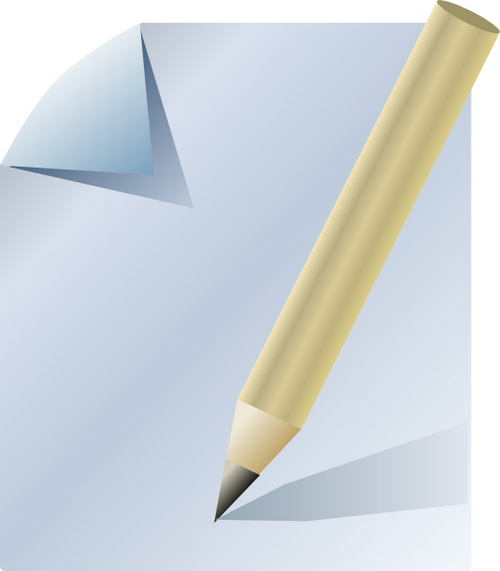
You will need
- Any text editor.
Instruction
A document file is a document created in any text editor. What text editors do you know? There are quite a few of them, from the standard solutions of the Windows operating system line, Notepad and WordPad can be distinguished. The fairly well-known file manager Total Commander includes a separate product - AkelPad, and the package Microsoft Office can offer the creation of a text document in MS Word. As you can see, there are plenty of applications in which you can create a document file.
Now let's look at how to create a document in the above programs. One of all existing simple programs for working with text - this is Notepad. It can be launched from the Start menu by selecting the notebook icon from the list of standard programs. When this application is launched, a temporary file is automatically created and saved to a folder designated by the operating system. When you exit the program, a message will appear on the screen asking you to confirm the request to save the file. You can also save the file in another way: click the "File" menu and select "Save As". In the window that opens, specify the path to the save folder and click the "Save" button.
The next text editor from the set of standard Windows programs is WordPad. This utility is also designed for writing texts and saving, but here you can format the text so that when printed it looks beautiful and is pleasant to read. The principle of saving a file in this editor has not changed compared to the previous opponent. True, the interface of this program in the Windows Seven operating system has changed slightly and instead of the usual menus, separate buttons have appeared, which looks much more convenient. To save the file, it is now enough to press the only button "Save" with the image of a floppy disk.
In the AkelPad editor, the principle of saving documents is the same as in notepad, so it makes no sense to write the same. The text editor MS Word keeps itself apart - with its help you can not only add formatting to the text, but also a description of some elements, it became possible to add hyperlinks, macros, inserts, etc. In versions of this program, starting with Microsoft Office 2007, navigation bars have completely disappeared and tabs have appeared for intelligent control. For saving, a separate “Save” button in the form of a floppy disk is highlighted, as in the case of WordPad in Windows 7. This operation can also be done by pressing the Ctrl + S key combination.
Related videos
Sources:
- how to create a document on a computer
files It is customary to name certain information stored in the required format. The most used extensions are .doc (for Microsoft Word), .png, .gif, or .jpg (for images), .xls (for Microsoft Excel spreadsheets), and .txt (for text files). The execution of the file creation operation is directly related to the program designed to open it.
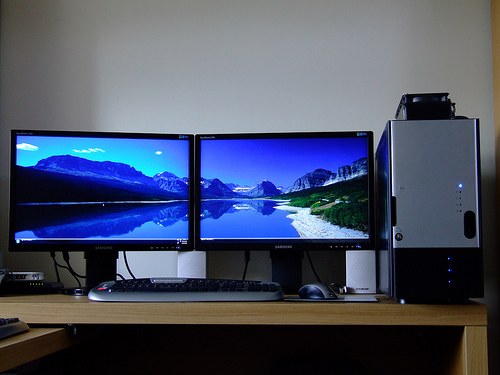
Instruction
Right-click on an empty space on the desktop to open the context menu and select "New".
Select the desired file type in the list of the submenu that opens and enter the desired name of the created file in the desktop shortcut that appears.
Expand the folder where you plan to create a new file and call the context menu by right-clicking on any empty place in the folder to create a new file using an alternative method.
With a computer for you. The most necessary Egorov A. A.
2.6.1. Text editors Notepad and WordPad
Notepad is the simplest text editor (Fig. 2.115). Notepad has minimal features for formatting text, but that's where it ends. Notepad is an indispensable thing when you need to write down something or quickly type a short text. The working window of Notepad consists of three elements: the title bar, the menu bar, and the workspace. The title bar contains standard Windows buttons and indicates the name of the document (usually the new file is named "Untitled"). The menu bar contains options for setting up the program and saving text.
Working space- where the text is written, i.e. entered from the keyboard; to write in large (uppercase, capital) letters, press and hold the key
Now let's take a closer look at the menu bar. On the menu File there are options for saving and opening the file.
? Create- create a new file. You can also open a new Notepad window with the keyboard shortcut
? Open- open file (Notepad reads files with txt extension). When you select this option, a dialog box appears in which you need to select the desired file. You can also use the keyboard shortcut to open the window
? Save- use this option to save the text you type. You can also use the keyboard shortcut . When you select an option, a dialog box similar to the one Open file, however, here you need to select a folder and write the name of the file under which you want to save it. The name can be both in Russian and in English language.
? Page settings- this option calls up a dialog box of the same name, in which you can select page settings, namely, sheets of format, for example, A4 or A5. You can also set the size of the margins (in millimeters) and sign the header and footer - the inscriptions that will be displayed when the document is printed.
? Seal- calls the print dialog box (Fig. 2.116). Of course, in order to print the sheet, you need a printer. In the window Seal you need to specify the number of the page you are going to print and the number of copies. The print window is also called up by pressing the keys simultaneously ? Exit- exit from the program. You can also exit the program by simultaneously pressing the keys Menu Edit mainly used for operations on text. ? Cancel- undo the last action. You can also use a combination ? Cut- cut selected text to clipboard ( ? Copy- copy selected text to clipboard ( ? Insert- paste text from clipboard ( ? Delete- delete selected text ( ? Find- find the right word in the text ( ? Replace- with this option you can replace one word in the text with another. Simply enter the word you want to replace and the word you want to replace with in the appropriate fields. ? Go- this one is in Notepad in Windows Vista and Windows 7. With this option, you can quickly jump to a specific line in the document. ? Select all- select the entire text to perform any operation on it ( Time and date - insert the current date and time into the text ( On the menu Format You can set word wrapping. Option Font Calls up a dialog box where you can select the font and font size. Menu View contains one option - Status bar, but most often this option is not available. On the menu Reference Notepad Help is located, where you can read about its functions and capabilities. The second text editor that is included with Windows is WordPad (Figures 2.118 and 2.119). WordPad is a little more serious than Notepad and has more "advanced" features - here you can change the font and text size, as well as add pictures. WordPad in Windows Vista and earlier versions differs significantly from the version of the program in Windows 7, so we will consider them separately. WordPad on Windows XP/Vista The working window of the program (Fig. 2.118) consists of a title bar, a menu bar, toolbars and formatting, a ruler, a workspace, and a status bar. Let's take a closer look at these panels. The title bar contains standard Windows icons, as well as the name of the text file you are working with and the name of the program. The menu bar contains several menus with options very similar to those in Notepad. Below are the toolbars and formatting, which contain buttons for operations on text. The workspace is slightly different from the notepad - using the ruler here you can set the size of the margins on the left and right. Also, words in the text can be highlighted in bold or italics, or the text can be made different size. The status bar usually displays hints for a particular option. The WordPad menu basically consists of the same options as the Notepad text editor. On the menu File there are the same options as in Notepad - here you can open and save files and print them, however, unlike Notepad in WordPad, you can save files in several text formats: DOC, RTF, plain TXT (as in Notepad), as well as in MS-DOS format - such text can also be opened in DOS text editors. However, we won't need it. There are advanced options for printing in WordPad - in addition to the standard printout of text, you can view the page (option Preview menu File) and set the page parameters by selecting the appropriate option. Under option Page settings on the menu File there are links to a few of the most recent documents you've worked on. Option Send allows you to send a document to e-mail. The program will launch an email client with which you can send an email with a file. Option Exit closes the program - if you are working with text and have changed its contents, the program will ask you whether to save all the results. Menu Edit dedicated to operations with text. As in Notepad, text can be copied to the clipboard, cut, pasted from the clipboard, deleted, select all text, search for the desired words and replace them. In addition, WordPad has the ability to paste special - you can paste data from another file by linking your document to another. The text or picture that will appear in your document will remain in the original file, and if you change the text in the linked file, it will automatically change in your main file as well. On the menu View you can add or remove panels - to do this, check or uncheck the box next to the name of the corresponding panel. Option Options calls the corresponding window, in which you can set the units of measurement, word wrapping and define some more options. Menu Insert contains only two options: date and time, which allows you to insert the current date and time, and An object, with which you can insert a picture, video clip, text from Word, Excel, and much more into the text. To insert an object in the menu Insert choose the option An object. A dialog box will open Inserting an object(Fig. 2.120). You can either create a new object or insert it from a file. To create a new object, select the object type and press the button OK. The corresponding program will start, with the help of which this object can be created. To create an object from an existing file, select the appropriate option and use the button Review find the required file. On the menu Format You can set text and display options. Selecting an option Font calls the dialog box of the same name (Fig. 2.121), in which you can set size
And type
font. Font size (size)
installed in the so-called paragraphs:
regular font size - 12 points, smaller font - 10 or 8. For headings, it is better to use 14 or 16 point size. There are several dozen font types, all of them can be viewed in the drop-down list Font. The most common are Times New Roman, which is used to type most documents (and even this book), and Arial. Font types differ in the pattern of lowercase and uppercase letters. Also in the dialog Font you can change the font style - make the text appear bold, italic or bold italic. WordPad also has the ability to modify the text - it can be strikethrough, underline, different colors. By default, the color is black, but you can make it red, yellow, blue, pink, cyan, olive, turquoise, or choose any other of the two dozen suggested colors. These features come in handy when you need to make some kind of announcement or postcard. In addition, in the window Font you can assign the character set of the input text - Cyrillic if you are typing in Russian, or West if you write in English. Option Marker adds a character before the text (marker)
- this function is required if you are creating a bulleted list. Items in such a list are not numbered, and each item is marked with such a marker. The list is created as follows - select the option Marker and type the text of the first paragraph, then press the key Using the option Paragraph, you can set the indents on the left, right and the indent of the first line. When an option is selected, a dialog box of the same name is called (Fig. 2.122). The distance is indicated in centimeters. To specify an indent (by default, all indicators are equal to zero), enter its value in the corresponding field. Also in this window you can specify the text alignment - it can be left, right or centered. Option Tabulation allows you to organize tabulation - in the window Tabulation, opened when this option is selected (Fig. 2.123), you can set tab stops. Type in the required tab stop (in centimeters) in the field and click the button Install, select it from the list and click the button OK. To use tabs, press On the menu Reference you can get information on working with WordPad (option Calling up help), the second option brings up a window About the program. Below the menu bar is the toolbar, which contains the main icons for operations with text, and we will consider them. Create new (blank) document. Open. Opens the file you were working on earlier. To open a text document, you can also go to the folder in which it is located and double-click on its icon. Seal. Print document. Preview document before printing. Find word in the document. Cut Copy the selected text or image to the clipboard. Paste from clipboard exchange text or image. Cancel. Go back one step. A very convenient and useful feature - if, for example, you erased something wrong, you can go back one step by pressing this button. Date Time. Insert date and time. When this option is selected, a dialog box appears in which you can select the available format for inserting the time and date. The formatting bar, located below the toolbar, actually repeats the options in the dialog box Font- here you can set the font, its size and select the character set. The following are buttons that set the style of the text: To change the text color, click the button: A drop-down menu will appear in which you can select the color of the text. Note To perform the above operations on text, select it and click the appropriate button. For example, to make text bold, select it and click the button: center: and on the right side: Only one position of text alignment can be active - usually the text is aligned to the left. The active position is highlighted with a frame: The next button inserts a marker: As you remember, the marker is also inserted by the command Marker menu Format. Using the ruler, you can set the beginning of the line and its end - to do this, drag the left and right arrows to the desired position with the mouse. The intended beginning or end of the document (depending on which arrow you are working with) will be displayed as a dotted line. WordPad on Windows 7 In Windows 7, WordPad has been significantly redesigned (Fig. 2.119). The options menus are gone and the button bars are on two tabs - home And View. Under the panels is the workspace, where the text is typed. To the left of the tabs is a drop-down list - it opens options for creating and saving documents (Fig. 2.124). With option Create you can create a new text document (this is also done using the keyboard shortcut Option Page settings opens a settings window where you can set margins, orientation (portrait or landscape) and page size. Quick access menu You can save an edited document by clicking the diskette icon in the title bar. Also pay attention to the drop-down arrow icon, to the right of the floppy disk. Open the dropdown menu - here you can add other options to the title bar to open and save the file. If desired, you can place these options under the button bar (tabs) above the workspace - to do this, select the option Place under the tape. On the tab home(Fig. 2.125) there are options for changing the size and style of writing the font, as well as inserting an image, object, date and time. The options have changed places a bit, but, in general, they do the same thing as in previous versions of the program. With Options Cut And Copy you can cut or copy text to the clipboard, and the option Insert- inserts a fragment from the clipboard into the text. In area Font You can increase or decrease the font size and the font itself. As with previous versions of WordPad, the font can be made bold, underlined, or italic. It also supports highlighting a fragment of text with a certain color and highlighting the background of the selected text with a certain color. In area Paragraph there are paragraph formatting options. Selected text can be aligned to the center, left or right, increase or decrease the spacing, and add a list to the text. In area Insert there are buttons with which you can insert the date and time, picture and object into the text. In area Edit there are options for searching for a word in the text, replacing and fully selecting text. On the tab View(Fig. 2.126) there are options for changing the scale and appearance programs. The scale changes in the area of the same name, where there are buttons to reduce and increase. In area Show or hide you can enable or disable the ruler above the workspace and the status bar at the bottom of the work window. In area Options units of measure are set on the ruler - by default everything is measured in centimeters, but you can set inches, points and peaks. However, here it is better to leave everything by default - we have long been accustomed to centimeters, and other units can cause difficulty. You can also set up word wrap here - if you wish, you can turn it off altogether, or it can be within the boundaries of the window or the boundaries of the rulers. Usually the last option is chosen. When it comes to typing, WordPad in Windows 7 is no different from previous versions. The text is typed in the work area. To make a capital letter, press the key Chapter 7 Mastering WordPad Like Notepad, WordPad is present in all versions of Windows. WordPad has more features than Notepad, but at the same time, it is significantly inferior to multifunctional word processing packages like Microsoft Word. At the same time, WordPad has more Text editors To work on scripts, you can use almost any text editor that allows you to create plain text files and save them in HTM or HTML format. For example, in the Windows operating system, among the standard there are two suitable text Notepad The Notepad program, contained in the Standard group of the Main Menu, is the simplest text editor (Fig. 6.12). With it, you can create, save, edit and print text documents. Rice. 6.12. Notepad windowNotepad window WordPad The next program of the Standard group is WordPad (Fig. 6.17). This text editor is similar to Notepad. The difference in the interface is that in the WordPad program window there is a toolbar located below the menu bar, and above the input area is located Notepad Notepad is the simplest program for working with text documents. While Word is the accepted text editor, allowing you to create documents with complex objects and formatting, you can use Notepad to quickly make Text editors Text editor is the third of major programs"gentleman's set of the application". And therefore this essay will be devoted to their consideration - both in general and on specific Notepad You can access additional properties for the font used in Notepad. DWORD parameters are used Strikethrough style - lfStrikeOut parameter with value 1 in HKCUSOFTWAREMicrosoftNotepad Underline style - lfUnderline with value 1 in section 6. Word text editors, of course, you have, but we also really like OmmWriter. When you launch it, everything else on your desktop disappears and soft music plays. This program plunges you into a state of total concentration. She writes beautifully Text editors Full-fledged office suites appeared in Linux relatively recently, but there are plenty of text editors for various purposes in this system. Sometimes there are even conflicts between supporters popular editors- for example, Emacs and vi. By Text editors Text editors Many users appreciate the quality of Microsoft products, but cannot put up with the cost. At the same time, they different reasons do not want to use Notepad, a program included in the standard Windows package. A good alternative to her is a small What can Wordpad do? Using the WordPad text editor as an example, let's look at some text formatting techniques, inserting pictures, and search and replace operations. Run the WordPad program: Start|All Programs|Accessories|WordPad. After running in the window workspace 5.1.2. WordPad and Notepad: text editing tools A word processor differs from a regular text editor in the ability to format text, insert various objects (pictures, tables, etc.) into the text. Windows has two editing tools: text Notepad The Notepad program (Notepad in the English version of Windows) is the most elementary tool for working with text (Fig. 17.1). Rice. 17.1. Program NotepadNotepad is included in the package Windows systems from its very first versions (since 1984). Moreover, today any operating WordPad WordPad is a more functional editor than Notepad (Figure 17.3). Rice. 17.3. WordPad program Its purpose is to provide simple text formatting. In this program, you can not only type characters, but also specify the font, paragraphs, alignment, Hello, friends. I am glad to welcome all readers of the blog website
. The topic of today's article will be the Notepad text editor. This is the simplest tool for working with texts, which is part of all Windows versions. Surely, everyone has heard of such a Windows application, but many do not use this reliable tool due to the fact that they do not know about all its capabilities. Notepad is used mainly for viewing and editing (without formatting) text files in the txt format. With it, you can also enter text from the keyboard and save it to your hard drive. Some users may have doubts about the need for this application. After all, Windows includes a much more functional WordPad text editor. However, the fact is that sometimes the editor is not required to have many functions. For example, if you need to write down some information along the way (phone number, account details, etc.), Notepad is simply indispensable. It opens from the taskbar almost instantly and is immediately ready to go. Notepad can be launched from the Start menu. To do this, click in sequence: " Start" --> " All programs" --> " Standard" --> " Notepad». To always have Notepad at hand, I recommend pinning the application shortcut to the taskbar. The Notepad application window (Fig. 1) does not contain any controls, except for the menu bar. Consider the Notepad menu item by item. File menu
Menu "File" (Fig. 2) includes the following items: Create. A new empty file opens. Open. Used to open text files. In the window that opens, find the desired file, select it and click the " Open". Seal… Printing out a document. In the window that opens, select the printer, page range, number of copies and click the Print button. Page settings… Set page options for printing. If necessary, here you can configure page settings: paper size, orientation, margin size, headers and footers. Edit menu
Menu " Edit"(Fig. 3) contains the following commands: Cancel. Undo the last action. Cut out. Cutting a previously selected piece of text and placing it on the clipboard. Copy. Copying a previously selected piece of text and placing it on the clipboard. Insert. Pastes a fragment of text (word) available on the clipboard to the place in the text where the cursor is. Delete. Delete a previously selected piece of text. (The deleted fragment can be returned to its place by clicking the " Undo"If no action was taken in Notepad after deletion.) Find... Search for characters, words or phrases. After clicking, the “Find” window opens (Fig. 4). Enter the word you want to find in the text in the "What:" field. Select the search direction (up or down from the cursor) and click the Find Next button. The correct word will be highlighted. Replace. Replacing words in text. After clicking, the window " Replace"(Fig. 5) opens. Enter the word to be replaced in the "What:" field, and the substitute in the "What:" field. Click the Find Next button, and then the Replace button. The desired word will be found and replaced. If the word that needs to be replaced is repeated several times in the text, click the Replace All button. Go... Transition (moving the cursor) to the desired line of the document. The command is active when the " Word wrap in the Format menu. Select all. Select all text. Time and date. Inserts the current time and date at the point in the text where the cursor is. Format Menu
Word transfer. Enabling this feature allows you to limit the length of the lines to the visible part of the screen, that is, there is no need to scroll horizontally. Font… Select font options. After clicking, the “ Font" window opens (Fig. 6). Select the type of font, its style and size in the corresponding fields of the window. Review the selected font in the Sample field. If you are not satisfied with any of the proposed fonts, follow the link " Show additional fonts". Select a font from the entire set of fonts available on your computer. Click the OK button. View menu
Menu " View"Contains only one item" Status bar» .
This displays the position of the cursor on the page (row, column) with the checkbox unchecked in the item “ Word wrap» Format menu .
Help Menu
Answers to some questions about the Notepad program are given. Specifies the version of the program. I draw your attention to the fact that for almost all Notepad application menu commands there are “hot keys” indicated in the command lines. The following keyboard shortcuts can be used to enter these commands from the keyboard. This concludes the article about the Notepad program. I really like this application for its simplicity and reliability. I hope that soon you will appreciate text editor Notebook. See you next time!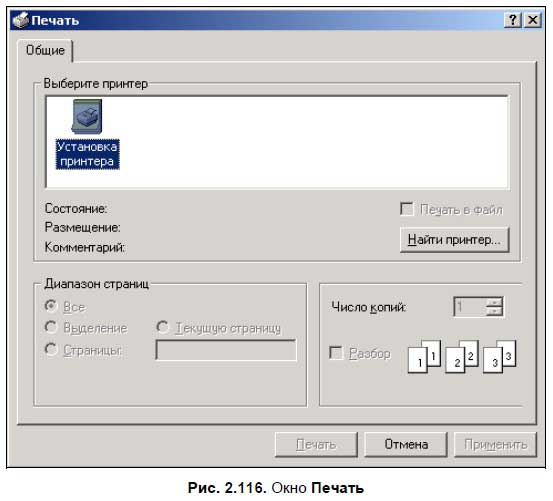
).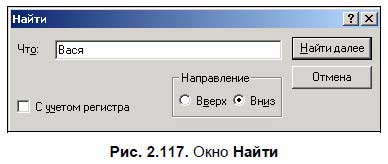
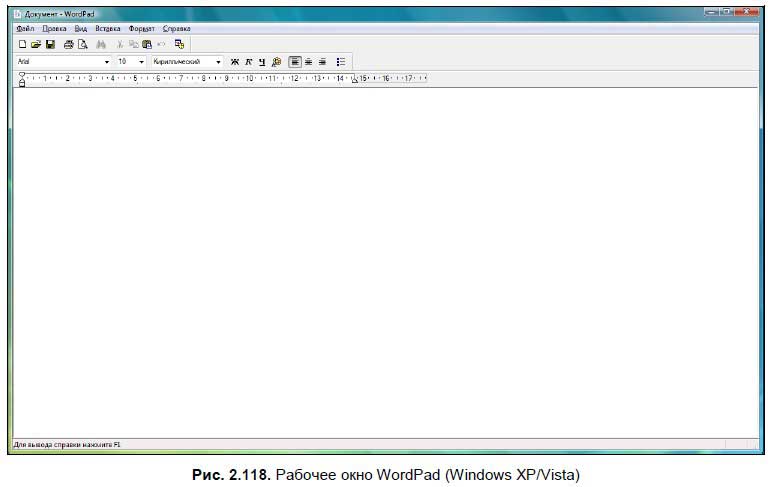
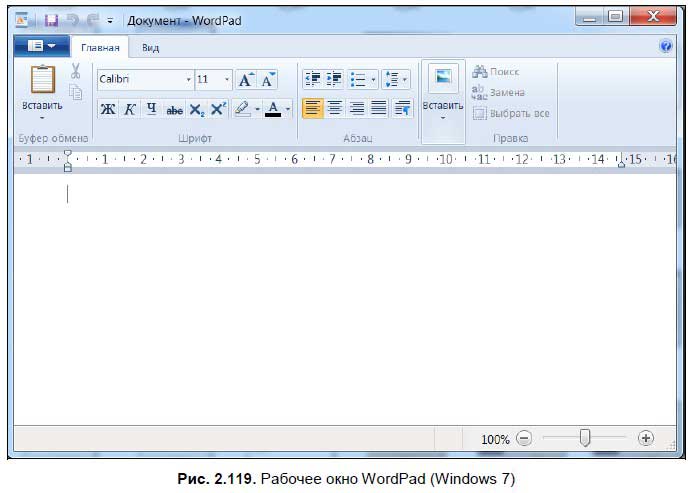
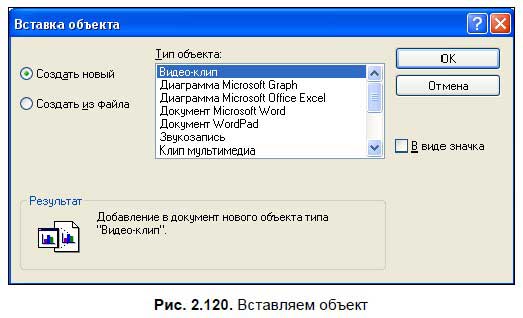
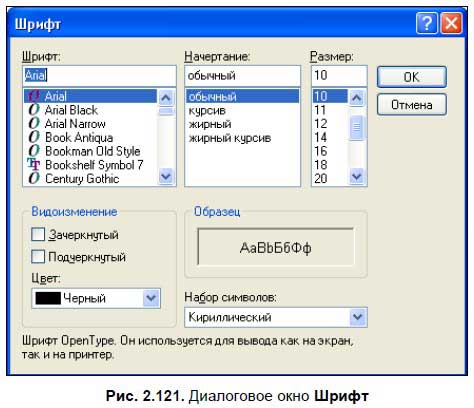
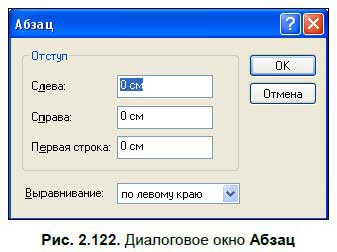
![]()
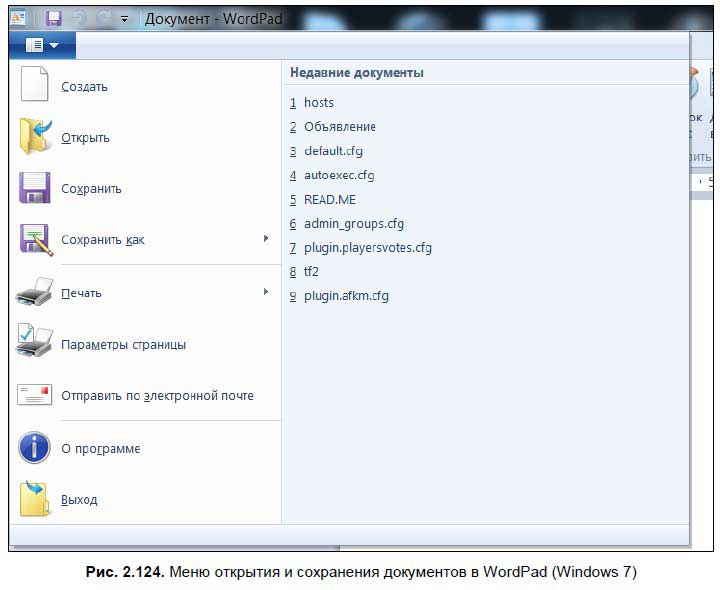


Starting the text editor Notepad
Text editor device Notepad
